Indentureship – Visions of the Past
Guyana Chronicle
May 6, 2007
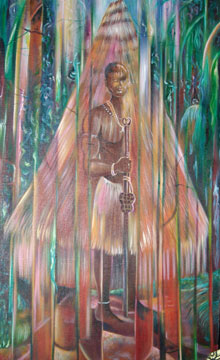
An African man, dressed in traditional wear, was painted by Brain Clark, a University of Guyana Arts graduate. The rod in his hand is synonymous with authority or stature. Juxtaposed are sharp objects, symbolizing the demoralizing of a people by slavery. It forms part of the Indentureship exhibition at the National Museum.
|
|
|
|
Indentureship
– Visions of the Past
WITH the passing of the Emancipation Act of 1834, the sugar planters of British Guiana, like their counterparts in other British territories, found themselves in a dilemma to replace the freed slaves.
And so the system of indentureship came into existence. People from different continents were trafficked to this part of the world, unsuspecting that their hearts brimming with joy of a bright future would be plummeted in despair.
Four groups of people were sailed to these shores under indentureship, and although the system came to resemble the face of slavery, it has left legacies of cultural traditions which influence our daily lives and which today forms modern day multi-cultural Guyana.
May 5 is observed as Arrival Day here, and even though the holiday takes on more significance for East Indians, who celebrate the arrival of the first batch of workers on May 5, 1838, it is also meant to reflect on the life of the Portuguese, Chinese and Africans who came under the indentureship system.

This painting by final year University of Guyana Arts student Brian Tankoon depicts a Chinese woman performing ancestor worship. In the background are dragons, mythical to Chinese culture. It forms part of the Indentureship exhibition at the National Museum.
|
|
|
|
For the seventh time, the National Museum is hosting an exhibition titled “Indentureship under the theme “Celebrating our Cultural Diversity”.
Presented in displays of artifacts, written material, photographs and paintings, it is a rich collection wrapped intrigue, disbelief, and wonder and delightful discoveries.
The exhibition opened Wednesday and runs until May 16.
The Chinese
A simple bird kite hangs at a section dealing with the Chinese, but it tells a truth not known about today’s kite flying craze at Easter time.

Philbert Gajadhar, University of Guyana Arts lecturer, says this painting of an Indian peasant girl, adorned in traditional dress, addresses the custom of Indian Hindus and Muslims wherein girls were not allowed to venture out alone, but accompanied only by a male of the household. She looks to the future, her peers are in the background. It forms part of the Indentureship exhibition at the National Museum.
|
|
|
|
Kite flying originated as a Chinese tradition to mark the beginning of spring. However, because of the plantation owners were ever so suspicious of the planter class, the Chinese claimed that it represented the resurrection of Jesus Christ.
It was a clever argument, as at that time, Christians celebrated Easter to the glory of the risen Christ.
The Chinese came to Guyana from 1853-1879. Among the favourite pastimes of the Chinese was opium smoking. There were many instances when the plantation owners had to deal with the fact that they were too “high” to work.

MASKS are an important component for African rituals and other celebrations.
|
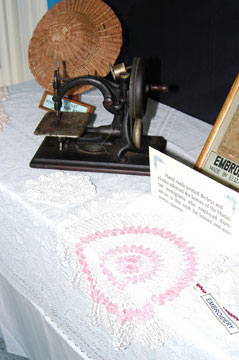
Knitted doileys adorned the homes of the Portuguese immigrants from Madeira.
|
|
|
|
|
The Chinese immigrants who came to British Guiana originated mainly from the south coast of China from such areas as Hong Kong, Canton, Amoy and Whampoa. Those who came were of two groups: Punti (who formed more than half of the population of the province of Kwang Tung, and who considered themselves the rightful owners of the soil) and the Hakka (squatters).
The East Indians
The largest group of indentured immigrants who came to Guyana were the East Indians, starting under Vreed-en-hoop plantation owner John Gladstone.
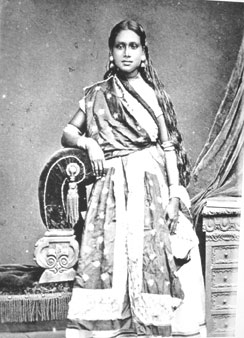
An Indian girl who came to Guyana under indentureship.
|
|
|
|
They came from different districts in the north and south of India. In the north, they came from Uttar Pradesh, Bengal, Bihar and to a limited extent Punjab. From the south, most originated from the Tamil and Telinga districts of the Madrass presidency.
They were shipped from the port of Calcutta, and the first batch arrived here on May 5, 1838 aboard the ship, Whitby.
Between 1838- 1858,a large number were “Hill Collies” (Dhangars, Mundas, Kols, Orgons) from Nagpur, a sub-division of the Bengal presidency.
Up until 1917, about 240, 000 Indians were brought to British Guiana and allocated to plantations around the country.
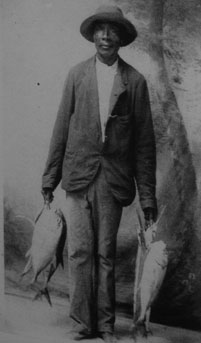
An African fish vendor who came to Guyana from Liberia.
|
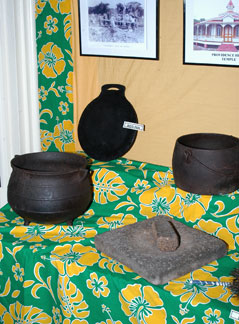
Cooking is one of the most important daily ritual of an Indian wife. Familiar implements, including the brick used for grinding massala, are displayed.
|
|
|
|
|
Much of the traditions they brought are fading, but the exhibition gives glimpses of what used to be practiced.
For example, displays of the “lorha” and “sil”, stones used to grind massala, showcases what were primary objects in the Indian woman’s kitchen. Though she too toiled on the plantations, cooking was one of the most important daily routines of an Indian wife. Many will tell you that coconut choka made from grinding roasted coconut with seasoning and pepper far out-tastes those made from today’s modern methods.
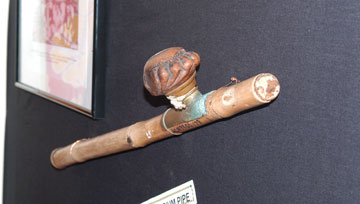
The Opium pipe Chinese used. Opium smoking was popular among the Chinese immigrants, with complaints that they were too “high” to work.
|
|
|
|
You will see too a checkered Rumal (headscarf), worn by Madrassi Indian women. The Rumal, (the plain white more recognizable) though still worn by some women, is quickly becoming a thing of the past.
The Portuguese
The Portuguese were the first set of immigrants to arrive in British Guiana under indentureship.
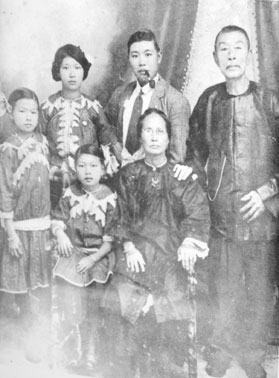
A Chinese immigrant family.
|
|
|
|
They left their homeland because of political instability, poverty and vain promises of El Dorado, the golden city. The first batch of 40 arrived on May 3, 1835 on the ship Louisa Baillie.
They came from the island of Madeira, and supposedly one of the reasons for bringing them was to balance the black to white ration on the colony.
However, they became unsuitable for the work because of the harsh climate.
The exhibition features hand made knitted doileys and cloaks which adorned the homes of the immigrants. They employed themselves in this craft for leisure and to make some money. They also crafted furniture.
The Africans
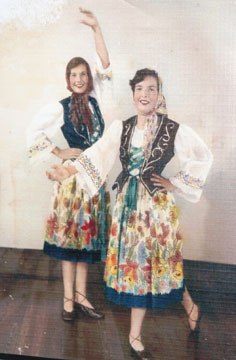
Two Portuguese dancers.
|
|
|
|
The trafficking of Africans to British Guiana was initiated in 1840 as a result of a temporary halt of the East Indian scheme and it became one of the most sensitive schemes.
It is not hard to imagine why there was skepticism. Many feared that it was the revival of the slave trade.
Those who came were from Sierra Leone and St Helena (of Yoruba and Congo origins). Others came from Liberia and the Cape de Verde islands.
On display at the exhibition are mask and drums, which are important components of African rituals and celebrations.
With this background the Africans have made substantial contributions to the development of the arts.










